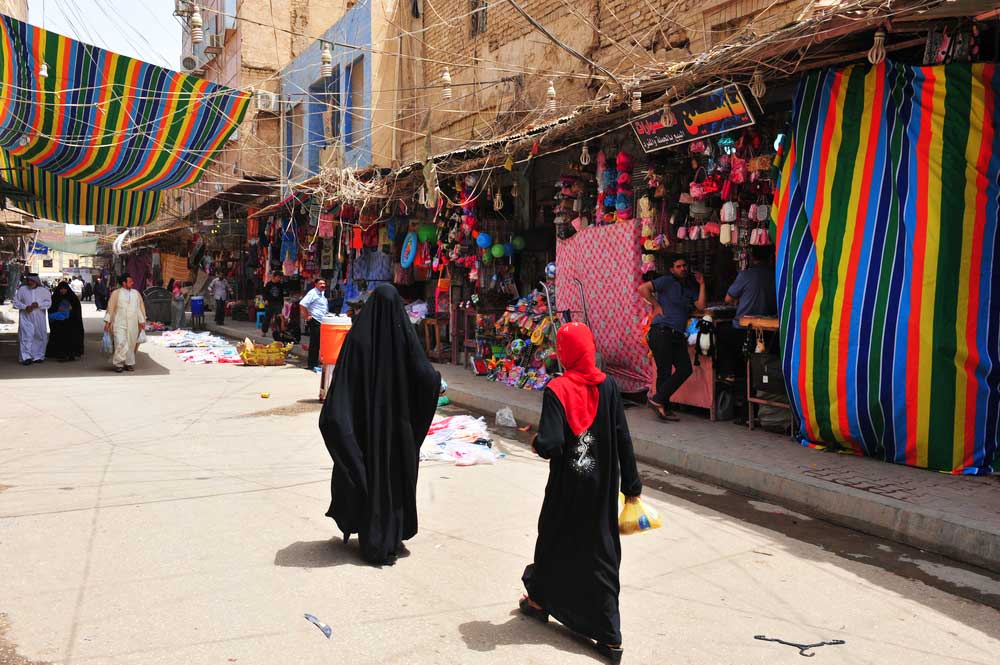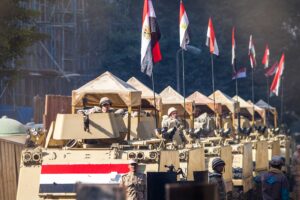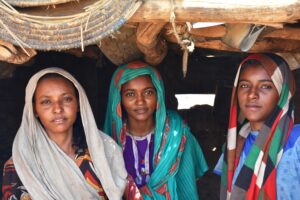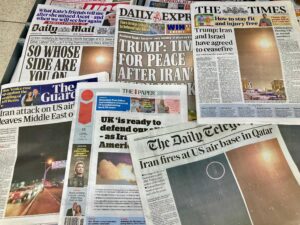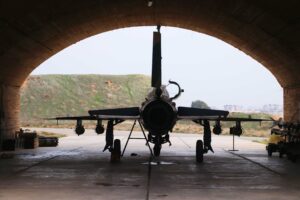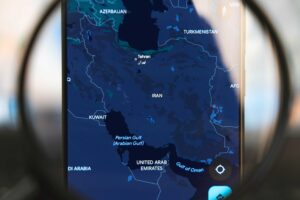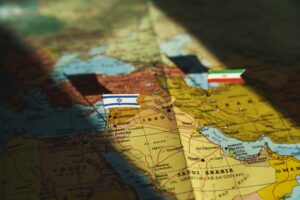In patriarchal communities, women’s dependency on men can lead to their being trapped in unhappy marriages and social settings. Education is a tool of empowerment for women, and those who nourish patriarchal systems view girls’ and women’s education with suspicion. “With Education You Can Face Every Struggle” is a three-part series that highlights the voices of Iraqi women seeking out, struggling for, and succeeding in higher education.
In order to hear the voices of educated and uneducated women in Iraq, we collected 74 interviews, 37 from women with higher education and 34 from women without higher education, including women who had never attended school at all. The interview process was part of a historical methods course at the American University of Iraq, Sulaimani, during the spring semester of 2019, in which we trained undergraduate students at the American University of Iraq, Sulaimani (AUIS) to conduct and transcribe two-hour oral history interviews[ia] The interviewees consisted of women from all over Iraq, including Iraqi Kurdistan. All of the women’s names are pseudonyms, and in several cases, upon request, identifying details have been altered as well. The age of the women is their age at the time of the interview.
Part Three: The Gender Problem
The first two parts of this series considered the barriers to education that girls and women face in Iraq, and the advantages that education, especially higher education, can bring. This third part of the series considers the state of gender studies in higher education in Kurdistan-Iraq. We collected information in 2014, and followed up five years later, about the availability of gender courses, or courses that include aspects of gender, in six Kurdish academic institutions. We collected information about the instructors’ experiences, including the problems faced by academics who teach gender-related courses in the cities of Sulaimani, Erbil, Koya, and Soran. Here we discuss the situation at our own university, the American University of Iraq, Sulaimani (AUIS), which is private but not-for-profit, as well as five public universities: Soran University, Salahadeen University-Erbil, Koya University, the University of Kurdistan-Hawler, and the University of Sulaimaniyah.[ib]
We used personal contacts to reach the appropriate people at the various universities. Getting information about older, more established universities such as Salahadeen University (initially established in Sulaymaniyah in 1968, and then moved to Erbil and renamed in 1981) and the University of Sulaimaniyah (established in 1968, moved to Erbil in 1981, and then re-established in 1992) was challenging in 2014. Information provided on the universities’ updated websites in 2019 was only slightly easier. Other than general information about the departments and the deans, it is difficult to obtain concrete information about the courses that are being taught and the academics who teach them, especially given the itinerant nature of instructors. In addition, even when lecturers and professors were aware that gender was being taught at any given university, they rarely knew in which department or by whom. This was different in the case of newer universities such as the University of Koya (established in 2003), the University of Soran (2009), and of course our own institution, AUIS (established in 2006).
Higher education empowers women, allowing paths to critical thought, expanded social and cultural familiarity, and awareness of gender equity.
We found that higher education empowers women, allowing paths to critical thought, expanded social and cultural familiarity, and awareness of gender equity, and that gender studies curricula amplify this potential. Gender studies programs in Iraq, while few and far between, do exist and have the possibility for expansion. As a first step toward this expansion, we must be aware of their background, the obstacles they face, the progress they have made so far, and their future potential.
The modern history of women’s rights in Iraq and Kurdistan
Inequality and injustice are normalized and they have become invisible to the majority.
In the last three decades, federal Iraq and the Kurdistan region have had different trajectories in relation to women’s rights. In 1991 and in the aftermath of the first Gulf War, the No-Fly-Zone was established to protect the Kurds from the Ba’ath government. The Kurdistan Regional Government (KRG) was established a year later, inheriting a destroyed rural infrastructure and a struggling economy. In the early 1990s, civil society developed, including women’s rights organizations. Now, more women have better access to higher education than in previous generations and some of the biased laws have been reformed. Despite many years of activism, however, the achievements of the women’ rights movement have been limited.[ii] Reasons for this slow progress include the resilience and vigor of the patriarchal system and the slow growth in the development of feminist consciousness amongst the general public. Overall, there is little acknowledgment that the status quo breeds a situation of oppression and domination. Inequality and injustice are normalized and they have become invisible to the majority. Gender essentialism prevails, not only among the older generations or those with limited education, but also amongst university professors and students. It should be noted, however, that this describes the situation in most parts of the world only a generation or two ago.
Article 14 of the Iraqi Constitution opened up the opportunity for women to mobilize for gender equality.
After the fall of the Ba’ath regime in Iraq in 2003, a new constitution was adopted and a new government was established. Article 14 of the Iraqi Constitution states that “Iraqis are equal before the law without discrimination based on gender, race, ethnicity, nationality, origin, color, religion, sect, belief or opinion, or economic or social status.” This opened up the opportunity for women to mobilize for gender equality.
Noga Efrati, working with the model in Ellen Fleischmann’s 1999 article, suggested in 2004 that the Arab women’s movement in Iraq, with its late start, was in its “awakening” stages, the first of three stages that end with institutionalized feminism, according to Fleischmann’s theorization of the phases of the women’s movement in the Middle East. Nearly two decades later, however, widespread feminism is still nowhere to be seen.[iii]
Utilizing the UN Security Council Resolution 1325 on Women, Peace and Security agenda, Iraqi women succeeded in establishing a quota system, mandating 25% representation for women in parliament.[iv] In 2009, the Kurdistan region raised the percentage to 30%. Unfortunately, the majority of the quota posts are allocated to women based on their political or tribal connections rather than their capability, leadership skills, and their commitment to advancing other women.[v] In many ways, because they lack sufficient knowledge and experience, these women are set up to fail in implementing gender equality. Some believe that these female MPs have “inflicted the largest blow” to women’s rights because of their ineffectiveness and lack of interest in women’s issues.[vi]
A quota system that is utilized to secure women’s representation in the parliament but women are chosen based on party loyalty.
Addressing the Kurdish women’s movement in Iraq, Choman Hardi speaks of an “invisible war” against the women’s rights movement.[vii] The components include: gender discriminatory laws that are reformed but implementation of the reformed laws is problematic; a quota system that is utilized to secure women’s representation in the parliament but women are chosen based on party loyalty rather than capability; gender units that are established to mainstream gender issues in several ministries, but this responsibility is added on top of other duties of the staff; and gender studies that are mandated, but the instructors are not provided with resources and training to help them succeed. Furthermore, there are chronic backlash and defamation campaigns against women’s rights activists.
Lucy Brown and David Romano trace the situation of Iraqi women, finding that many gains under Saddam’s Ba’athist regime were also lost. The end of the regime in 2003 also brought mixed outcomes: some empowering and others leading to more vulnerability. The end of the regime in 2003 brought a new constitution and government policies that were favorable to women, but the ongoing problem with security in Iraq, combined with sectarian war, the rise of tribal and conservative forces, made it unlikely that the situation would improve.[viii] Over fifteen years on, their forecast seems all too accurate.
Despite the work of activists and civil society organisations, and despite reformed laws, some Kurdish women continue to be marginalized, silenced, and, if they fail to abide by expectations, killed.
Brown and Romano go on to contrast the Kurdish region with the center and south of Iraq, saying that “the northern Kurdish autonomous region continues to make progress toward increasing women’s empowerment, autonomy, and integration into public life.”[ix] Feminist critics of the Kurdistan Regional Government (KRG) have long argued that the progress made in relation to women’s rights is more cosmetic than real.[x] Despite the work of activists and civil society organisations, and despite reformed laws, some Kurdish women continue to be marginalized, silenced, and, if they fail to abide by expectations, killed. Brown and Romano are aware of the relative nature of this progress and they clarify that: “women’s status in Kurdistan may be described as more positive in relative Iraqi terms but still lags far behind countries in the West as well as most of Latin America, Sub-Saharan Africa, and Asia.”[xi] The authors then make connections between democracy with women’s rights, stating: “Leaving the liberation of Iraqi women to a later date, after democracy and the liberation of Iraqis in general has been achieved, decreases the chances of achieving either.”[xii] They also argue that because of the lack of organized women’s interests groups from the general population (what the authors call the bottom-up approach), “the best hope for Iraqi women remains those Iraqi governing elites, international NGOs, foreign governments, United Nations personnel, and current occupying authorities willing to support progressive gender initiatives.”[xiii] However, reliance on outside funding is one of the problems associated with this women’s rights movement, in particular because of changing funding trends and agendas, and competition for resources between different groups in the community[xiv].
A new idea for an old problem
The year 1971 does not seem so ancient, yet the revolutionary idea put forth by Audrey Cohen, the founding president of Metropolitan College of New York, known for experimental and experiential learning, seems quaint now, if predictive.[xv] She suggested, as part of her “first steps to break social patterns that confine women to inferior roles”,[xvi] a “female studies program”[xvii] as an academic way to change the view of women, and even to “develop a new image of women as human beings.”[xviii] Although she had nothing to do with the women’s movement in Iraq, Cohen’s legacy is important internationally. She proposed courses such as “Women’s Role in Society” and “The Image of Women in Literature and Art.”[xix] By the time her essay was published, the first two academic women’s studies programs had been established. Now women’s and gender studies are a standard part of academia in many universities in the world, along with a wide variety of related studies (queer studies, masculinities, and so on)—available from the introductory first-year class to Ph.D. specialization. It is useful to remember that what once was a startlingly radical concept about the curriculum was soon woven into the academic fabric within fifty years. Joan Scott’s piece “Gender: A Useful Category of Historical Analysis,” suggesting that the gender lens could be a useful and valid academic tool, appeared in 1986.[xx] That gender is a useful academic tool hardly needs explaining three decades later.
A bigger challenge to incorporating gender studies into a fragile infrastructure is deeply held conservative attitudes about gender equality and roles.
Gender studies is less a standard part of academia in Iraq than in the global north. There are special challenges to implementing gender studies in Iraq. Sabah Fehan (2013) names nine main challenges to higher education on the whole in Iraq. She notes the infrastructure; faculty and staff qualification; the availability of textbooks; the paucity of scientific research; the overall quality of the education system; weak linkages between educational institutions and labor markets; poor governance of educational institutions; little attention paid to the quality of teaching staff; and poor quality control of the graduates. A bigger challenge to incorporating gender studies into a fragile infrastructure is deeply held conservative attitudes about gender equality and roles. Nevertheless, several universities in Kurdistan have managed to incorporate gender into their curricula.
The first gender studies center in Iraq, the Gender and Violence Study Centre, was established in 2011 when Dr. Najat Muhamad was the head of the sociology department at the University of Sulaimaniyah, a public university with 19 colleges.[xxi] Dr. Najat relates how she was approached in the Autumn of 2010 by the president of the University of Sulaymaniyah and Dr. Nazand Begikhani of the University of Bristol with the idea of a gender center. The center was originally named “Center for Gender Studies and Gender Based Violence.” A protocol was signed between the University of Sulaimani and the University of Bristol with the support of the British Council and others to set up the center.
Dr. Najat faced various obstacles and difficulties. Her own peers did not take her seriously; some even disregarded her and told her that they did not believe in such ideologies. Regardless, she mentions how three other colleagues decided to help her with the project. Another obstacle was the set of misconceptions that surrounded the concept of gender. Dr. Najat recalls how the male faculty would pass by and look away in discomfort. Gender itself was a concept that was misconstrued. It was regarded by society as women’s sexuality, homosexuality, and promiscuity.
Nearly two years of joint funding was secured from the British Council and Ministry of Higher Education in Erbil to start the center in coordination with the Centre for Gender and Violence Research at the University of Bristol. Most of the funding, according to our interviewees, ended up at the University of Bristol in the UK. The center in Sulaimani was given a few thousand dollars for books and equipment, and the four academics who started this center (Dr. Najat Hama Faraj, Dr. Nian Namiq Sabir, Dr. Jwan Bakhtiar, and Dr. Payman Abdulkader) were invited on a two-week trip to the UK, one week of which consisted of attending lectures on gender studies at Bristol University. The second week consisted of visiting women’s organizations and shelters in London. The four women then established a year-long course which included three hours of instruction per week. The first part of the course focused on the concept of gender; the second section focused on theories of violence; the third part consisted of the theories of gender and violence; the fourth section narrated various nations’ experiences in terms of gender. Three years later, and after much criticism (see below), these women gave up teaching the course and leading the centre, and others took over from them. Now, three undergraduate courses in gender are offered at the university: a sociology course, “Family and Gender,” taught by Dr. Alia Faraj Mustafa, and two social work courses called “Gender” and “Gender-based violence”, taught by Dr. Zhiea Abas Kadir. The last two courses are a result of a three-year collaboration between the university’s social work department with Bochum university, which started in 2016. The Fine Arts department has also offered gender related courses on and off. After several changes in leadership, the Gender and Violence Study Centre survives, though not, it seems, robustly.
Soran University was established in 2009. Three years later, Dr Said Shems, who received his Ph.D. in Britain, established the Department of Sociology there. In 2012, the bilingual program (in Kurdish and English) had eight instructors and 55 students. One of the aims of the program, as stated on the department’s website, was to familiarize students with issues such as “gender roles, displacement, family care, inequality, or gender-based violence,” and to prepare them to question social phenomena and equip them to do scientific research.
Soran University received funding for a gender studies center in 2015. This was a joint initiative to be funded by UNWomen, UNDP, the KRG High Council for Women’s Affairs, the Ministry of Planning, and Soran University. After “Introduction to Gender” in the first year, which was taught in Kurdish, students were to go on to take a one-year course, in English, with Dr. Ana Cristina Marques, about the history and theory of gender as an analytical tool. The module consisted of four hours a week and lasted the entire year. The program had the support of Dr. Muslih Mustafa, president of Soran University. This support was the main reason the center survived the various attempts to undermine it by academics and students (see below). Unfortunately, with the 2015 expansion of ISIS in Iraq, the resulting humanitarian crisis, and the drop in oil prices, the Kurdish government was not able to keep its agreement in terms of funding. Currently, there is a modest, unfunded revival, with a course devoted to gender studies taught regularly at the second and third level in the Faculty of Arts.
At Salahadeen University in Erbil, the oldest public university in the region, Ms. Lawlaw Abdulaziz, who completed her M.A. on gender as a category of social inequality, confirmed that she was the only person, in 2014, who included gender analysis in her courses in the university. At that time, she taught a course on social control, and the following year she taught a course on social psychology. In both courses, each extending over a full academic year, she devoted a few lessons to gender. “Including gender is not a requirement” she added, “but the sociology department gives professors a free rein to teach various topics within the framework of their courses.”
Without any teaching material in Kurdish (articles or books), Ms. Lawlaw translated a summary of texts from Arabic and gave it to her students. In her experience, female students were more likely to come back and ask more questions after these lessons. Since they had learned that the differences between men and women are biologically determined, exposure to the possibility of social construction opened up many questions, and unsettled the students.
Dr. Shno Ahmad lamented, in 2015, the shrinking of the social sciences at Koya University, a public institution with 440 academic staff (in 2019). In the few years up to 2015, the Department of Languages stopped teaching French and Kurdish, the sociology programme closed down, as well as that of Islamic studies. Some courses that were taught as part of psychology also disappeared from the curriculum. Gender was not being taught at this university, but Dr. Shno did not believe that it would never be taught. Every four years there is a conference about the academic program, where new courses can be proposed. She believed that before proposing a course on gender, it would be important to conduct a study about its usefulness and chance of success. Students, she observed, are interested in courses and degrees that secure them employment in the public sector, which is seen as a comfortable future because of entitlement to pension along with job security. While researching the possibility of establishing new courses, Dr. Shno found students to be suspicious. “What would be my job title?” they asked her. She believed that one obstacle against introducing gender studies was this mentality. The larger context includes the sustainability of the humanities in general when students are encouraged by their families to choose the sciences instead.
Ms. Katherine Carter, at the public University of Hawler in Kurdistan, used to teach a course on gender in the sociology department, which is now closed. Dr. Emel Elif Tugdar joined the Department of Politics and International Relations in the spring semester 2014, and included gender in her courses, but she is no longer with the university. According to the website, gender is now part of the BA in Global Politics and Diplomatic Studies.
At our institution, AUIS, a private, not-for-profit, American style institution, the first official course on gender, developed in 2013, was part of the Department of English under the name of “Gender, Media and Society.” This semester-long course, which continues to be taught regularly, explores gender issues in society with a particular focus on media. It aims to provide students with a broad understanding of gender, social construction, and media representations of men and women, and the consequences of these representations within the wider society. Themes that are explored include masculinity and femininity, hegemonic masculinity, sexist language, gender stereotyping, advertising and the beauty myth, pornography, and the sexual objectification of women.
CGDS, whose focus is on teaching, research, and community development, launched the first minor in gender studies in Iraq in 2017.
Dr. Choman Hardi established the Center for Gender and Development Studies (CGDS) at AUIS in 2015. CGDS, whose focus is on teaching, research, and community development, launched the first minor in gender studies in Iraq in 2017. At this writing, it remains the only gender minor in Iraq. Nine courses from three departments (English, Math and Sciences, and Social Sciences) are on offer, with additional courses in development. CGDS visiting scholars supplement AUIS faculty.
In October 2018, the EU awarded a substantial, two-year grant to the center for a project to effect gender equity through education in the MENA region. With this funding, CGDS provided consultation, teaching, and training on gender equity, and promoted social justice in the K-12 system through training and textbook assessments. The center also produced music, podcasts, and short films. The largest component of the three-year grant project was translating, into Kurdish and Arabic, key gender studies texts in four areas: law, media, pedagogy, and social work. These texts are available free of cost on an online platform to university instructors from the MENA region who wish to incorporate gender studies into the curriculum. The platform also provides online training to professors who are new to gender studies.[xxii] In 2019 CGDS received another substantial multi-year grant to study masculinities in Kurdistan in partnership with the London School of Economics.[xxiii]
Obstacles to teaching gender studies
Whatever the funding situation, there are many obstacles. People who teach gender at universities in Kurdistan are generally first-generation academics. As a result, they bear the brunt of many barriers and challenges. Dr. Shems (Soran University) pointed out that some of his colleagues complain that gender is not relevant to Kurdistan; others complain that it is anti-Islam and therefore should not be studied. Dr. Najat (University of Sulaimaniyah) confirms that some fellow academics believe that gender is not important, and should not be studied. In her experience, the female academics are the most outspoken complainants. There is also academic rivalry when academics in gender studies are invited to conferences outside the country. Most department members prefer that participation in such events be decided by the head of department, who is not always supportive of scholars active in gender studies.
Dr. Shems also stated that students complain that studying gender is not useful or necessary. They keep arguing that other universities in Kurdistan “don’t have to” study this subject, so why should they? He found that female students like studying gender more than male students, and estimates that half of the young men openly oppose and dislike the subject.
Ms Lawlaw (Salahadeen University) pointed out that the majority of students and instructors believe that the word gender means homosexuality, a stigmatized concept:
A group of students did their final project on gender; one of the male professors told them: “You are girls, you should not research about unethical issues such as homosexuality.” They told him that he had misunderstood the term, but he insisted that it meant homosexuality and that Ms. Abdulaziz’s dissertation was also about that.
Dr. Najat talked about the difficulties they faced when she started Sulaimaniyah University’s gender center. After they hung their sign (reading “Centre for Gender and Violence”), faculty members said that when they passed it, they had to turn away because the words were really ugly. Three times they hung the sign; three times it was taken down. They are still not certain who was removing the sign, but they gave up displaying it.
A university instructor who wished to remain anonymous stated that “religion is still the stronger influence [than education] and many [students] continue to believe what they are being told by conservative Imams.” Dr. Najat confirms this: teaching a gender studies course was a significant challenge. “When I went into class it was like going to a battlefield. You would open your mouth and they would oppose you. Once a student said to me, ‘just don’t say that word, Doctor, because it is an awful word.’ There were problems about that word in the Parliament before that.”
A widespread attack on the word gender by the Imams [toook place] at the end of 2010 when the term was first used in a bill proposed by the Ministry of Culture and Youth.
Dr. Najat was referring to the widespread attack on the word gender by the Imams at the end of 2010 when the term was first used in a bill proposed by the Ministry of Culture and Youth. For a few weeks many Imams dedicated their Friday sermons to attacking the term and in turn attacking the women’s movement. This put pressure on President Barzani not to sign the proposed law and instead return it to Parliament so that they could remove the offending word. Islamic scholars also issued a statement urging the Parliament to reject such words that are “incompatible with Islam.” In January 2011 Mullah Krekar, a well-known radical Islamic leader, announced that he wanted to clarify the word gender to the Kurdish public. The word, he said, simply means “ganganoke,” a crude word which is equivalent to “fucking.” He argued that, unlike the word gender, “ganganoke” is an easy Kurdish word that everyone understands.
Dr. Nian (Sulaimaniyah University) spoke about one of her female students who was taking part in group work. The young woman asked: “Why do we study this? God in the Quran had said that women are mentally inferior to men.” Even though this is not true, the young woman believed what some Imams had told her. Both Drs. Najat and Nian warned that: “You have to be very careful, pay attention to the background of students. They might call you infidel.” To avoid major problems and help students understand the basic issues of gender, Dr. Nian used the Quran and hadith in her teaching. “I know that the students will understand [and connect] in this way.” Some students, she pointed out, find it difficult “to understand scientific texts, if you do not link them up with religious texts.” Dr. Najat also tried to “close the gap” between herself and the students:
“You have to make them first like you so that for your sake they will listen. You have to oblige them. You have to… say the subjects in a way that they won’t reject them. … I have changed myself so much to get them to accept me. We have to make students listen to us.”
Personalities definitely matter in Iraq classrooms. If one alienates students at the beginning, no matter what is said later or how right it is, they will not listen. Professors commonly talk about the limitations of both male and female students in terms of intellectual confidence, critical and independent thinking, and background knowledge.
A professor who did not want to be named also stressed the negative influence of some conservative religious values which prevent young women from being strong and independent, making them fearful and insecure instead:
“When you come to some of the departments it feels as if you are coming to a mosque. Amongst 50 female students only one does not wear the hijab. They are not religious; a large part of it is backwardness, not religion. A closed, conservative mind thinks that making his daughter wear the hijab will protect her. He does not know that if he had made her strong, she would not need the hijab, and it is his own fault. He has brought up a weak daughter and now he is scared. And he doesn’t know that this hijab does not protect her. We have seen this, we have experienced how this does not protect girls. Therefore she has been set many red lines and it is difficult for her to accept what you say.”
The way forward
Dr. Najat confirmed that, despite all the difficulties, change does happen: “I remember the first time I taught gender. At the end of the three months, the course ended really well. The students learned.” The men, she observed, had been having difficulty at first because they had been taught that women are their honor, and it is difficult for them to change their long held views. She “asked them to do a report on noticing gender differences and the boys did it too, their life experiences, their relatives. They are worth turning into stories and books.” In fact, a male student told her, “I believe in what you are saying.” He went on, though: “but now I will return to my village and I cannot relay these things in my village. They would disown me. I would not be able to open my mouth.”
Students learning about gender are under a lot of pressure. They have been raised on one set of principles and now they are being asked to consider another, which radically opposes the first. This process is lengthy and cannot be without complications. Still, according to the academics in the University of Sulaimaniyah gender center, some students have finally understood what gender means. This does not necessarily mean they will change deeply or in terms of their social practices, but at least the first step has been taken. Things have changed so much so that the department head, who initially wanted to close down the gender center, took an interest in research on gender.
In our own experience, we have also seen changes. Towards the end of Dr. Choman’s first semester teaching a gender course, on a day of uncertainty when she doubted that what she was doing made any difference, she asked the students whether they had learned anything in the class. One of her male students, usually quiet, relayed this experience:
“Last night at 11:30 I was on the street, walking alone. I saw a girl, also walking alone. My first question was: ‘What is this girl doing on the street, this time of the day?’ My next question was: ‘What am I doing on the street, this time of the day?’ It is only because of this class that I asked myself the second question.”
This is exactly what she was hoping the students would learn: to question their long-held views about women’s and men’s entitlements, roles, and statuses. She knew that this would be more difficult for the male students. Another student gave her the following feedback on the class evaluation form (the forms are completed anonymously at the end of the semester):
“The class was very useful showing some stereotypes about gender issues…. Students realized that feminism does not mean having hatred toward men or prioritizing women over men. Also, the class taught students about how violence and mistreatment about women have been normalized by patriarchal societies. We also covered the side effects of using women’s body in advertising, and to what extent we use sexist language in our daily conversations. Taking the Gender, Media and Society course will teach you how to see women as equal as men, and how to stop subordinating women, starting with yourself.”
Echoing many of the observations in Part Two of this essay, of the women who had gained the skills of independent critical thinking, another student wrote:
“The course was a good introduction to gender studies. It was really useful. When I listen to a speech, I can find whether the language she/he uses is gender biased or not. I can do the same about readings. When I am watching news and films, I try to be aware of subconscious messages that they carry. After the course, I see the world differently, looking for ways to not be part of the patriarchal status quo. However, I find it disappointing that we cannot go further and have more courses about topics, such as colonial feminism, feminism and nationalism, and sexual politics.”
In August 2018, the KRG Ministry of Higher Education decreed that all of Kurdistan’s universities must establish gender centers and teach courses in gender.
These six universities are only a portion of the higher education institutions in Iraqi Kurdistan. There are 11 public and several licensed private universities. In August 2018, the KRG Ministry of Higher Education decreed that all of Kurdistan’s universities must establish gender centers and teach courses in gender. This resulted in the establishment of more than 20 gender studies centers in public and private universities. Currently many universities are seeking to teach gender related courses. In fact, we learned recently that the Lebanese French University in Erbil planned to have a conference on gender studies in spring 2021, but had to cancel because of the pandemic. We have been unable to make contact with anyone there in order to include the information here. Overall, the universities in Kurdistan have the potential to develop and teach gender studies, with a little support and a few resources. Just as some of the women without education in Part One of this essay stated that opposition and circumstances had worn them down, it seems that efforts to teach gender have also been defeated, in many cases, by both intentional and circumstantial obstacles.
One solution to the issue of funding, discussed above, may be ringfencing funding for women’s rights issues such that the onset of a new conflict or humanitarian crisis does not suspend the work of women’s rights organizations or impede their progress. Another solution would be to let the people on the ground, who are aware of their community’s needs, drive the funding agenda rather than international donors and agencies.
Universities can serve as a bridge between the “bottom-up approach” mentioned above and other actors, many of whom tend to be disconnected from the reality of women’s lives.
We would also add to this list of actors who might be willing to support progressive gender initiatives universities in Iraq, especially those in Kurdistan, given the relative positive status of women that Brown and Romano cite. In fact, universities can serve as a bridge between the “bottom-up approach” mentioned above and other actors, many of whom tend to be disconnected from the reality of women’s lives. Bakhan A., 49, a graduate in the English program from Sulaimani, clarifies the link between education and gender sensitivity: “If you’re not educated you can’t know what the gender problem is, and you cannot recognize the inequality happening in our community.” Through education, men and women can be sensitized to their communities’ inequalities. Many dramatic social changes have originated and developed in the university setting.
Conclusion
Universities have served as the catalysts and centers of social and political change, historically and worldwide, and there is no reason why this should not be the case in Iraq. Perhaps the most profound impetus for universities as loci of gender equity in Kurdistan, at least theoretically, has come through the August 2018 decree by the KRG Ministry of Higher Education. The decree is not without problems: it was not associated with any funding; some directors of the gender centers had no wish for the position and no interest in the topic; a cabinet change took place, delaying the implementation; and there is still, at this time writing, no solid plan for coordination among the universities. The learning curve is steep: the difference between sex and gender, for example, is usually a new concept for the academics who will teach the courses and direct the programs. Still, this is a laudable decree that, once implemented, will change the face of academia. In turn, as long as the universities interact with their communities, avoiding the Ivory Tower trap, the face of the landscape will alter for the better, for men as well as women.
Previous article in this series:
[ia] We thank the interviewees, as well as the AUIS students who carried out the interviews: Mr. Adam Tawfeeq, Mr. Ahmed Taha, Mr. Al Ameen Jasim Al Jabbari, Mr. Alfarooq Ahmed, Mr. Bahat Muhammed, Mr. Basman Nazar, Mr. Bawan Adil, Ms. Beritan Khalid, Ms. Dalya Othman, Ms. Danyal Rasul, Mr. Danyar M. Faraj, Mr. Dashty Rasul, Mr. Dastan Khdir, Mr. Davar Abdulla, Mr. Dekan Rahim, Ms. Evan Jaaf, Ms. Fro Kamil, Mr. Hawsar Saed, Mr. Hedi Hamadamen, Ms. Jwan Aziz, Mr. Karmand Muhsin, Mr. Lawand Ali, Mr. Luay Kheder, Ms. Mariam Majid, Mr. Mohammed Hussein, Mr. Obai Moamin, Mr. Rand M. Salih, Ms. Raz Yadulla Qololus, Ms. Roza Aziz, Ms. Rozh Kamal, Ms. Sara Abd, Ms. Sawa Hama Salih, Ms. Sawen Amin Ali, Ms. Shireen Fakhri, Mr. Wrya Wahab, and Mr. Yihia Hamza. We also thank the Center for Gender and Development Studies Research Assistant Mr. Ali Hussein Azeez Abo-Jadya for his work on processing the transcribed interviews. The interviews were conducted in English, Arabic, and Kurdish, and sometimes a combination of two or three languages. They were all transcribed and translated into English. For the sake of consistency and easier reading, we have eliminated “fillers” such as “umm” and repeated words, and we have corrected the spelling errors and typos that resulted from transcription, as well as grammatical mistakes such as pronoun agreement that resulted from translation.[ib] There are many variant spellings of the city.
[ii] Choman Hardi. 2013. “Women’s Activism in Iraqi Kurdistan: Achievements, Shortcomings and Obstacles.” Kurdish Studies Journal, 1.1 (September): 44-64.
[iii] Noga Efrati. 2004. “The Other ‘Awakening’ in Iraq: The Women’s Movement in the First Half of the Twentieth Century.” British Journal of Middle Eastern Studies 31. 2: 153, 73. http://www.jstor.org/stable/4145506. Accessed 17 February 2022.
[iv] Nadje Al-Ali and Nicola Pratt. 2010. What Kind of Liberation? Women and the Occupation.
of Iraq. University of California Press; Andrea Fischer-Tahir 2010. “Competition, Cooperation and Resistance: Women in the Political Field in Iraq.” International Affairs 86.6: 1381-1394.
[v] Fischer-Tahir 2010; Hardi 2013.
[vi] Hardi 2013.
[vii] Hardi 2013; Choman Hardi. 2021. “The Women’s Movement in Kurdistan-Iraq.” The Cambridge History of the Kurds. Bozarslan, H., Gunes, G., and Yadirgi, V. (eds). Cambridge University Press.
[viii] Lucy Brown and David Romano. 2006. “Women in Post-Saddam Iraq: One Step Forward or Two Steps Back?” Feminist Perspectives on Peace and War: Before and after 9/11 18.3 (Fall): 51-70. https://www.jstor.org/stable/pdf/40071181.pdf?ab_segments=0%252Fdefault-. Accessed 17 February 2022.
[ix] Brown and Romano 66.
[x] Hardi 2021, 882.
[xi] Brown and Romano 66.
[xii] Brown and Romano 66.
[xiii] Brown and Romano 67.
[xiv] Choman Hardi. 2019. “Gender Issues in the Context of a Humanitarian Crisis”. Center for Women, Peace, and Security: Research at LSE.
http://eprints.lse.ac.uk/104050/1/Hardi_Gender_issues_humanitarian_crisis_published.pdf. Accessed 20 March 2022.
[xv] Audrey C. Cohen. 1971. “Women and Higher Education: Recommendations for Change.” The Phi Delta Kappan 53. 3: 164-67. http://www.jstor.org/stable/20373124. Accessed 17 February 2022.
[xvi] Cohen 164.
[xvii] Cohen 166.
[xviii] Cohen 166.
[xix] Cohen 167.
[xx] Joan Wallach Scott. 1986. “Gender: A Useful Category of Historical Analysis”. The Historical Review. 91 (5): 1053. doi:10.2307/1864376. Accessed 17 February 2022.
[xxi] “EU Project: CGDS’s Interview with Dr. Najat Mohammad Faraj,” a podcast, can be found at https://auis.edu.krd/CGDS/video/eu-project-cgds’s-interview-dr-najat-mohammad-faraj. Accessed 12 May 2022.
[xxii] All items can be found in “Enhancing Education, Developing Community, and Promoting Visibility to Effect Gender Equity in Iraq and the Greater Mena Region,” https://egender.auis.edu.krd. Accessed 12 May 2022.
[xxiii] “London School of Economics Selects AUIS as a Lead Institutional Research Partner.https://auis.edu.krd/CGDS/event-milestone/london-school-economics-selects-auis-lead-institutional-research-partner. Accessed 12 May 2022.


